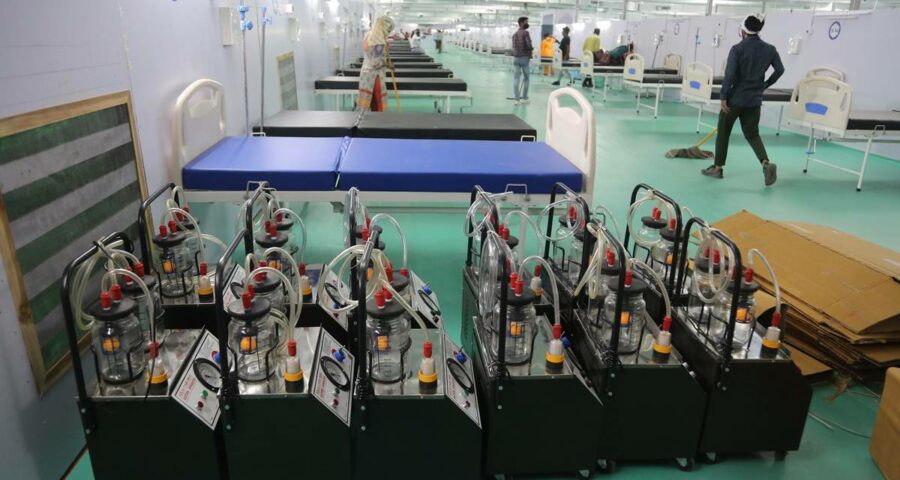A total 13 states have more than 1 lakh active cases; six states have 50,000 to 1 lakh active cases; and 17 states have fewer than 50,000 active cases, the Centre said. The total active case count across the country is now more than 37 lakh.
As many as 533 of the country’s 700-plus districts are now reporting a test positivity rate of more than 10 per cent, the government said on Tuesday, underlining the massive spread of the coronavirus infection in rural India in the second wave.
A total 13 states have more than 1 lakh active cases; six states have 50,000 to 1 lakh active cases; and 17 states have fewer than 50,000 active cases, the Centre said. The total active case count across the country is now more than 37 lakh.
“Since the second wave is raging”, it is time to dilute the Health Ministry’s earlier recommendation that no more than 30 per cent of all Covid-19 tests should be Rapid Antigen Tests (RAT), Dr Balram Bhargava, director general of the Indian Council of Medical Research (ICMR), said.
Instead, to increase access and availability of testing in rural areas, RAT needs to be used aggressively by setting up testing centres in schools and community centres, Dr Bhargava said.
Rapid Antigen Tests are easier to give and provide quick results, but are significantly less accurate than the RT-PCR tests, considered the gold standard of testing for the virus.
“India is facing a massive upsurge in Covid-19 cases. The national positivity rate is around 20-21 per cent, and about 42 per cent districts in the country are reporting a positivity rate more than the national average. Early testing, isolation is key to control transmission,” Dr Bhargava said.
“Sometimes we have to wait for the [test] results,” he said. Therefore, “In the second wave, we have rationalised RT-PCR tests and increased RAT testing for early detection… Earlier our recommendation was 70 per cent RT-PCR test and 30 per cent RAT, but now since the wave is raging, we have requested (states) that we have to do more RAT tests. This will result in faster tests, faster isolation and faster breaking the chain of transmission,” Dr Bhargava said.
To increase RAT, a multi-pronged strategy including setting up 24×7 testing booths in cities, towns, and villages, and in schools, colleges, and community centres; and lifting the accreditation requirement for RAT facilities, needed to be implemented urgently, he said.
Given that only a limited number of facilities were offering RT-PCR tests, Dr Bhargava said tests must not be repeated in individuals who have tested positive once either in a RAT or RT-PCR test; no testing is required for recovered individuals at the time of discharge from hospital; and there is no need for an RT-PCR test in healthy individuals undertaking inter-state domestic travel.
“Virus is made of RNA particles; it can stay in the system for many days. RT-PCR tests only detect RNA. The test can come positive for many days after symptoms and infectivity have subsided. In these recovered patients, the live virus is not there. So there is no testing required at the time of hospital discharge,” Dr Bhargava said.
In five states, more than 30 districts each are reporting case positivity of more than 10 per cent, the Centre said on Tuesday — Madhya Pradesh (45 districts), Uttar Pradesh (38), Maharashtra (36), Tamil Nadu (34), and Bihar (33).
In eight states, more than 20 districts are reporting positivity of more than 10 per cent : Karnataka (28), Rajasthan (28), Odisha (27), Chhattisgarh (24), Gujarat (23), Haryana (22), West Bengal (22), and Assam (20).
Another eight states have more than 10 districts with a case positivity of more than 10 per cent: Jharkhand (18), Punjab (18), Kerala (14), Arunachal Pradesh (13), Andhra Pradesh (12), Himachal Pradesh (12), Uttarakhand (12), Delhi (11).
“We have already told states that in districts that are reporting more than 10 per cent positivity, strict containment measures have to be undertaken. Currently, there are 533 such districts in the country, where stringent action needs to be implemented,” Lav Agarwal, joint secretary in the Ministry of Health of Family Welfare, said.
The Centre said that for the week May 5-11, 26 states have reported more than 15 per cent positivity; six states have reported 5-15 per cent positivity; and only four states, less than 5 per cent positivity.
Six states and three Union Territories have an alarmingly high case positivity of more than 25 per cent, the Centre said : Goa (49.6 per cent), Puducherry (42.8 per cent), West Bengal (34.4 per cent), Haryana (34.3 per cent), Karnataka (32.4 per cent), Rajasthan (30 per cent). Chandigarh (27.5 per cent), Andhra Pradesh (26.2 per cent), and Delhi (25.7 per cent).
Fourteen states and two UTs continue to report an increasing trend in daily new cases: Karnataka, Kerala, Tamil Nadu, West Bengal, Odisha, Punjab, Assam, Jammu & Kashmir, Goa, Himachal Pradesh, Puducherry, Manipur, Meghalaya, Tripura, Nagaland, and Arunachal Pradesh.
Source: Read Full Article


